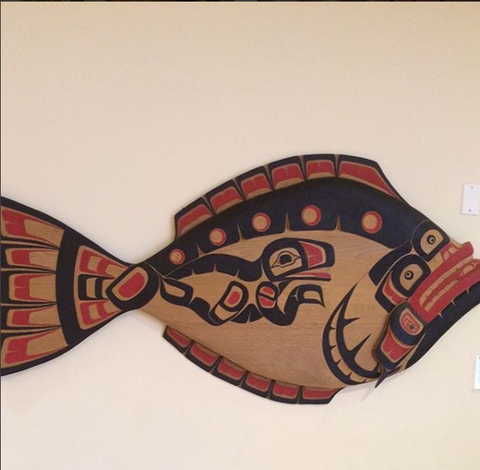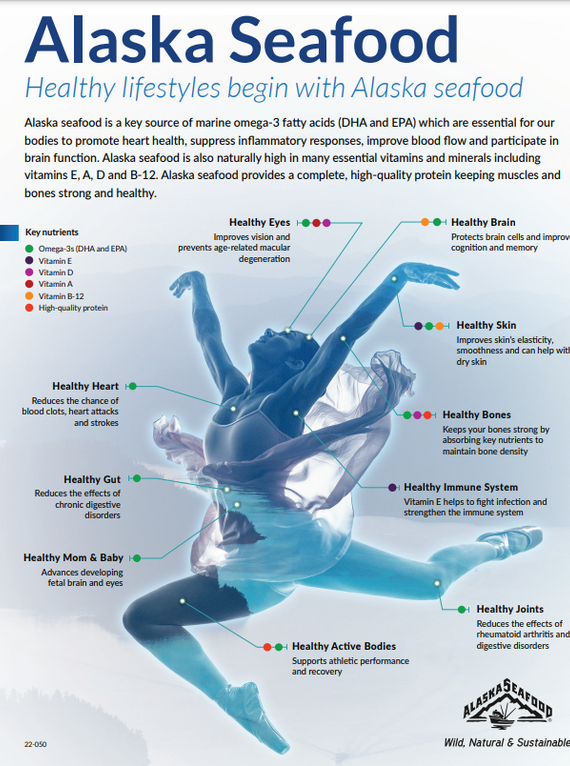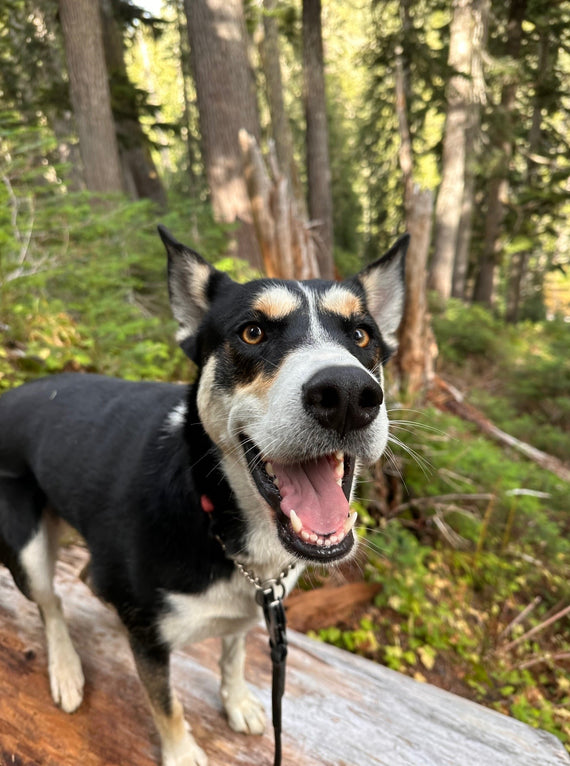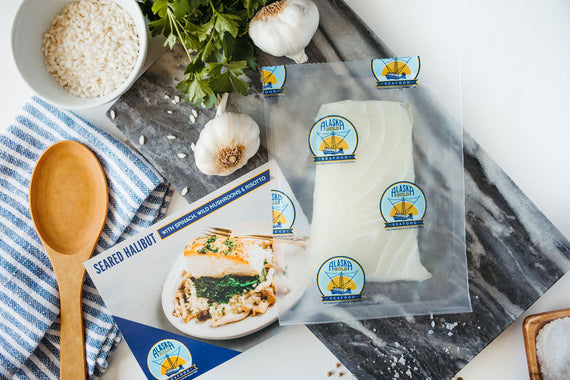
What's so special about Alaska Gold Halibut?
Simply put, our Alaska Gold Halibut is special for its luscious flake, which is delicate but meaty. Its snow white meat is naturally sweet with a delicate flavor and firm but silky texture that retains its shape with any cooking style.
Halibut is the world's premium white-fleshed fish, making it wildly popular with all kinds of chefs. Halibut are delicious cooked in a variety of ways--this pan-seared halibut recipe is just one of an endless number of possibilities for halibut. One of our favorite ways to prepare halibut is this Seared Halibut with Spinach, Mushrooms and Risotto Recipe.
Pacific halibut (Hippoglossus stenolepis) are a type of flounder. Hippoglossus means "horse tongue," which refers to the halibut's large mouth and tongue. Stenolepis means narrow scale and refers to the halibut's tiny, almost invisible scales.
Halibut are as flat as a board and spend a good portion of their lives roaming the ocean floor. What's unusual about halibut is that they are born with eyes on each side of their head--however, after six months their left eye migrates to join the right eye on their "dark side," giving halibut two eyes on the same side of their heads. Their top side or "dark side" with two eyes is a dark green-ish to brown-ish color to match the color of the ocean floor. This color camouflages them from predators like sharks and orcas (killer whales) who also enjoy the taste of a fine halibut. During the summer, halibut feed on the continental shelf, but then migrate to deeper waters during the winter, spawning somewhere on the continental slope along the way.
Wild Alaska Halibut Nutrition
Wild Alaska halibut is a lean, high-quality, complete protein with all nine amino acids. Just three ounces of halibut include 19 grams of protein (38% of the recommended daily value).
In addition, 3 ounces of halibut contain 201mg of Omega-3 fatty acids. Omega-3s contribute to heart and brain health, as well as being good for the skin.
Halibut is also a good source of Selenium with a 3-ounce piece giving you 85% of the daily recommended value. Selenium can act as a powerful antioxidant, prevents cognitive decline, and is important for thyroid health.
Wild Alaska Halibut Sustainability
Our Alaska Gold Halibut are harvested in the waters near Sitka, Alaska, home of our fishermen-owned co-op. Alaska Seafood is managed for sustainability, so you can rest assured our fishermen's grandchildren can fish for halibut.
There are Atlantic halibut, too. The Seafood Watch program recommends Pacific halibut coming from Alaska. Pacific halibut stocks are healthy and carefully managed. Similarly, the Marine Stewardship Council (MSC) certifies Pacific halibut. It is also rated green on Monterey Bay Aquarium Seafood Watch eco-ratings. Our Alaska Gold Halibut is MSC-certified.
Since Pacific halibut cross international borders between Canada and the United States in their migrations, in 1923 the International Pacific Halibut Commission (IPHC) was formed. The IPHC was the first international treaty in the world established to protect a marine resource.
Biologists from both countries work together to preserve halibut populations for future generations. The IPHC has maintained a stable fishery and avoided stock and environmental problems that have affected other parts of the world. Fisheries scientists around the world look at the IPHC as a model of good fishery management.
Fishing for Halibut
Our fishermen are busy harvesting halibut between March and December. Fishermen work within a quota system with the amount of halibut they catch monitored by biologists in order to maintain a sustainable population of halibut. Fishermen pick a "weather window" in which they think they'll have clear seas and good fishing to go harvest.
Sitka is a major port for halibut because of its proximity to waters rich with marine life and the continental shelf.
In Southeast Alaska, the Tlingits harvested halibut during spring and this rich bounty from the sea made the Tlingits one of the richest societies in human history with nourishing foods and meaningful arts. The word Sitka comes from the Tlingit word "Shee A'tiká, or people from outside of Shee island (which has been called Baranof island by Europeans).
Traditional Tlingit halibut hooks consist of two pieces of wood, usually alder and cedar, lashed together at an angle of roughly 30 degrees with split spruce root. They used a rock as an anchor and fished in canoes up and down the coasts of what we now call Alaska and British Columbia.
If you visit Alaska, you can see the Tlingit culture in totem poles, headdresses, canoes and food preservation techniques.

A "Healing Halibut" in the Tlingit art style spotted at the Fred Hutch Cancer Center in Seattle.
The long lines used today, though operated on somewhat bigger boats with diesel power, work with principles that aren't that different than those used by the Tlingits. Typically, long liners use an anchor and buoy to spread long lines baited with salmon, squid or herring on a "ganion." After 12 hours or so of "soaking" the lines on the bottom of the ocean, the captain finds the buoy and the fishing crews haul up the lines and halibut using what the fishermen call a gurdy, or a hydraulically powered winch used to pull up the heavy lines. Our fishermen pull the halibut over the rails of the boat. Then they dress, clean and ice each halibut quickly to preserve quality.
Male halibut can reach 100 pounds but females can weigh upwards of 500 pounds. Bigger fish mean more eggs. A 50-pounder lays about 500,000 eggs. A 250-pounder can lay 4 million eggs. Large halibut are called "barn doors," because they're flat, large and you can imagine what it's like to haul them up from the bottom of the ocean--hard work! When they're smaller they eat shrimp and small crabs. Then they move on to octopus, squid and other fish.
Our Alaska Gold halibut are caught by fishermen like Dick Curran, the Humble Highliner, who have an incredibly close connection to the special waters where our fish come from. Our quality comes from a pride in being fishermen-owned for more than 75 years. Halibut are particularly important to the history of our fishermen-owned cooperative, which was formed by fishermen who processed halibut in Seattle. Up until 1980, Seafood Producers Cooperative was the Halibut Producers Cooperative. The name changed to more accurately reflect the other fish being caught (particularly wild salmon and black cod), but halibut has always been an important part of the history of our fishermen-owned co-op.
We're particularly fond of the delicate texture of halibut and its sweet flavor. Alaska Halibut's culinary virtues are many. Halibut's versatility in combining with different flavors makes it a favorite for high-end restaurants and savvy home chefs alike.
***
A lot of the information from this blog post is shared in a beautifully illustrated, kid-friendly book by Lauri Sadorus: Pacific Halibut: Flat or Fiction?



